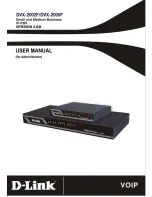
PBX Code Method
PBX-1 (PBX
Code: 20)
TIE Line Network
Private network
PBX-2 (PBX
Code: 30)
Outside Caller
PBX-3
PBX-4
PBX-5
PBX-6
PBX-7
Telephone Company
Extn. 102
Fwd to Unified
Messaging
PBX-8
Extn.
101
Extn.
101
Unified Messaging
Mailbox 101
Mailbox 201
Mailbox 730101
Mailbox 730102:
"Hello. I am not at
my desk right now."
Mailbox 730102
"7-30-102"
[TIE line
access no.]
[Extn. no.]
[PBX
code]
[Explanation]
Extension 102 does not answer the trunk call, so the call is forwarded to the Unified Messaging system, using
a mailbox number containing the
TIE line access number
, the
PBX code
of the PBX that received the call,
and the
extension number
that received the call.
This mailbox number is the same as if an extension connected to PBX-1 called extension 102 of PBX-2. This
mailbox number should be programmed as the mailbox number and owner extension number on the Unified
Messaging system.
Multiple Voice Mail Services
More than one PBX in a network can provide voice mail services to extensions connected to other PBXs.
Conditions
[General]
•
This section explains Centralised Voice Mail assuming that the Unified Messaging system is being shared.
If you want to use the Centralised Voice Mail feature with a VPS over a stacking connection, refer to the
documentation of the PBX from which you will share the VPS.
•
KX-NSN002 (Activation Key for QSIG Network) is required for all KX-NS series PBXs that will use this
feature, whether they are hosting the voice mail service or just using it.
Note
Centralised voice mail is used only among PBXs connected over a TIE line.
•
A separate activation key is required for non-KX-NS series PBXs. For details, refer to the corresponding
Feature Guide.
•
All PBXs in the network must be KX-NS series, KX-NCP series, KX-TDE series, or KX-TDA series PBXs.
For information on the hardware requirements for non-KX-NS series PBXs that share the same voice mail
service, refer to the corresponding Feature Guide.
Feature Guide
457
4.3.5 QSIG Enhanced Features
Содержание KX-NS500
Страница 14: ...14 Feature Guide Table of Contents...
Страница 15: ...Section 1 For Your Safety Feature Guide 15...
Страница 18: ...18 Feature Guide 1 1 1 For Your Safety...
Страница 19: ...Section 2 Call Handling Features Feature Guide 19...
Страница 40: ...PT Programming Manual References 720 Doorphone Call Destination 40 Feature Guide 2 1 2 Internal Call Features...
Страница 57: ...632 Maximum Number of Agents Feature Guide 57 2 2 2 Incoming Call Distribution Group Features...
Страница 107: ...User Manual References 1 2 1 Basic Calling Feature Guide 107 2 5 4 Trunk Call Features...
Страница 174: ...Feature Guide References 2 21 2 Flexible Buttons 174 Feature Guide 2 11 6 Flash Recall Terminate...
Страница 193: ...User Manual References 1 4 2 Holding a Call Feature Guide 193 2 13 1 Call Hold...
Страница 228: ...User Manual References 1 7 1 Paging 1 7 2 Answering Denying a Paging Announcement 228 Feature Guide 2 17 1 Paging...
Страница 321: ...2 1 4 Turning on the External Background Music BGM Feature Guide 321 2 30 1 Background Music BGM...
Страница 324: ...324 Feature Guide 2 30 2 Outgoing Message OGM...
Страница 325: ...Section 3 Unified Messaging System Feature Guide 325...
Страница 375: ...Section 4 Network Features Feature Guide 375...
Страница 464: ...464 Feature Guide 4 3 6 Network ICD Group...
Страница 465: ...Section 5 System Configuration and Administration Features Feature Guide 465...
Страница 506: ...Feature Guide References 6 1 Capacity of System Resources 506 Feature Guide 5 2 4 Portable Station PS Features...
Страница 560: ...560 Feature Guide 5 6 7 PING Confirmation...
Страница 561: ...Section 6 Appendix Feature Guide 561...
Страница 578: ...578 Feature Guide 6 5 2 PFMPR Software File Version 004 2xxxx...
Страница 579: ...Feature Guide 579 Notes...

































